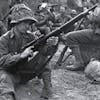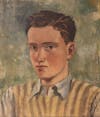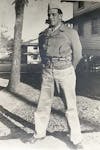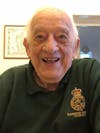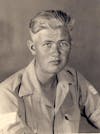63 Jean Lindsay, Child of the Second World War

Zeppelins, Doodlebugs and Meeting Americans
Jean was a youngster when the second world war broke out.
She describes her first sinister sighting of a German airship – a Zeppelin
She tells of her evacuation from Norfolk to Nottinghamshire early on in the war.
She’s got stories of deadly WW2 Doodlebugs and Bombings
Learn about the rather naughty practical joke she and her friend played on allied airmen.
And there’re yet more japes with the British Home Guard and the local American troops.
There’s a return to rationing as a young girl recalls her experiences
Learn how the Americans loved their Fish and Chips.
And how American cheer lifted the spirits of the British population
Finally, what an absolutely marvellous wartime birthday present for a young girl!
Full show notes, links and photos
Feedback/reviews - Thank you.
YouTube channel - Loads of my own videos - Dunkirk Mole, Gold Beach, more ...
Jean Lindsay

More great unpublished history!
Second world war
Interested in Bill Cheall's book? Link here for more information.
Fighting Through from Dunkirk to Hamburg, hardback, paperback and Kindle etc.
Fighting Through Podcast – Episode 63 – Jean Lindsay, Child of the Second World War
More great unpublished history! WWII
Feedback
I’d like to give a shout out and thanks for the great feedback from Dan Chambers Texas, Cutterman70 from Australia and Rds USA
Rick Lord From New Hampshire, U.S.A. has said:
It occurred to me that in the past you have shared some of your experiences traveling across the Channel so thought I’d do the same.
I will particularly mention the area around and the city of Bastogne in Belgium - and Operation Wacht am Rhein – Watch on the Rhine, better known as Battle of the Bulge.
A follower of all military history I've always been most fascinated by the Battle of the Bulge. And I’m Fighting and losing my own presently!
I arrived in Bastogne a summers day in late July, 1981. When my travelling companions moved on, I stayed.
I spent about a week quietly walking and accepting rides around the area. I've been to Waterloo and other places like it, but never felt the spiritual connection I felt there.
I suppose had I made it to Normandy I should never have left.
Last summer in Orange, Massachusetts, was a WW2 get together. Battling Americans and German reenactments, all nations from the period represented in some re-enactment with fortifications, camps, et cetera.
Also, a C-47. Not just any C-47. Whiskey 7. The actual plane. This aircraft was the lead plane for the 82nd airborne and the lead plane for the second wave of U.S. paratroopers on the night of June 5/6. AND... Possibly the coolest thing I've ever had the opportunity to do, my wife bought (surprise) tickets for us to fly in her. And a good long 30 plus minutes it was.
I remember you and, more precisely, your Dad, when I leave goods at the homeless shelter.
Peace,
Rick Lord
P.S. I'm off to fire my Enfield mk4 No 1 at my spot. A living piece of history.
Richard thanks for sharing that little memoir of your travels - we'll be posh and call it a vignette. I hope we all have such personal memories of our own of some holiday in the past, I know I have, and you're right about spiritual connections and I certainly feel that when I go to Gold Beach. And my goodness, same for the Menin Gate at Ypres in Belgium – if ever there was a place when you could cut through the atmosphere – it’s sending a shiver right up my spine as I say this.
At which point thank you for remembering Dad when you visit the food shelter that I know you donate to with the podcast in mind. And that's a reminder, dear listener, if you want to support the show financially, there are links at the FTP.co.uk website and I'm passing monies onto the Salvation Army to help with all the good work they do. If you prefer, donate direct to a charity of your choice. Thank you. And thanks to Rick for giving me the timely opportunity to mention all that.
One final comment Rick, you mentioned you were off to fire your Lee Enfield at your spot. That does sound a tad uncomfortable and I don’t know where your spot is but be bloody careful cos if it’s on your buttocks you might just blow your arse right off!
TR
Magnus Lundin FB
Has sent in a link to a great colourised by ww2colourisedphotos.
https://www.facebook.com/worldwarincolor/posts/2917939658335807
Justin Sa
Via Facebook has kindly sent in an interesting link about a girl nicknamed Itchy Boots touring the world on her bike and sharing the video on you tube. And it seems to me to be a very timely opportunity to spend a socially distanced 15 minutes doing a battlefield tour without the touring bit.
Here’s what Itchy Boots says on her web site
My name is Noraly. I’M a 33-year old, Dutch, solo-female traveler and I'm passionate about motorbikes, and crazy adventures. I quit my job and sold my stuff - now I'm a full-time adventure rider and take my motorcycle to all remote corners of the world!
So, for a taste of biker babe meets ww2, check out the Itchy Boots tour of Holland - 75 Years of Freedom –
You can view her, really excellent quality, tour of Rotterdam, Nimegen, and Arnhem at the link in the shownotes.
Ingo Bräutigam Germany
Best wishes from Ingo Bräutigam Germany
Ingo sent me a link to a youtube vid called the lost d-day documentary, posted up by someone called Slidepast.
Apparently there were originally Four film reels, discovered by researchers at the Eisenhower Library in 2014, and they were found to contain the first ever documentary of the D-Day landings. Intended as an initial report and produced in only days, the film was screened for military leadership and is mentioned in OSS reports as having been viewed by Winston Churchill, with copies 'flown to President Roosevelt and Mr. Stalin.'
The film was then lost and forgotten for decades, before it was found and digitized by the US National Archives and Slidepast says he’s done his best to restore and enhance the footage. And I’ll say Slidepast – you really did do a great job with it. Very impressive film quality. The link is …
Ingo thanks for sending that link and also for buying Dad’s book. And did I say, it is now available in paper back from Amazon and Pen and Sword? So if you want a great memoir on one man’s personal journey through the entire six years of the second world war, a book that has over 120 five star reviews on amazon, fill your army boots with it now, in time for Christmas. So that’s FTFDTH from Pen and Sword Direct or Amazon, Ebay and indeed any book seller. Hard backs are becoming quite rare but if that’s what you want contact me direct and I’ll quote you a price and postage. I will sign it for you and include a FT bookmark, souvenir photos and a smile – that’s for the few hardback copies I have left. There are links in the show notes at FTP.co.uk
LINK
Tim Rainville, Canada
I continue to listen avidly to your various podcasts and despite my lifelong interest in the subject, you continue to find new, intriguing accounts to relate.
In a recent podcast you read several listener e-mails and one, in particular, struck a chord. Someone from the U.S. described his grandfather contracting Scarlet Fever and credited that with possibly saving his life.
I had heard of a similar twist of fate from a Canadian veteran with whom I had the great pleasure of spending time with over the course of a 10 day battlefield tour in 2007, in northern France.
His name was Stan Highway. He had served with the 17th Duke of York's Royal Canadian Hussars (Recce - part of 3rd Canadian Infantry Division).
Even at the age of 91, in 2007, he required no assistance and scampered over hill and dale like a man half his age. He drove his own car until age 98. A wonderful man with a perpetual twinkle in his eye.
I recall being amazed when he climbed down a stone wall and took a solitary walk along Juno beach. That mobility belied his condition in the spring of 1944, when Stan suffered a seriously broken leg while, what else, playing hockey.
As a result, he was unable to land on D Day with his unit. He did fully recover and was able to finally rejoin his squadron in August 1944.
By the time he arrived in France everyone in his original Troop, including his replacement, had been killed. Stan was convinced that the broken leg had very likely saved his life by keeping him out of battle during the costly Normandy campaign.
On D-Day his B Squadron was tasked as Beach Exit Parties and Brigade Contact Detachments on Juno Beach.
By July 17, the entire regiment was functioning as a Unit and continued to do so until the German surrender in 1945. Stan served until the end of the war with no further wounds or injuries.
Sadly, he passed away in Montreal on January 28th, 2017 at the age of 101.
Cheers,
Tim Rainville
Richmond Hill, Ontario
Canada
Tim thanks so much for that. What a great story. It reminds me of my dad’s own situation where he couldn’t sail out to North Africa in 1941 with his pals because of illness. And when he finally got out there he discovered the majority of them had been killed in action! Lucky or what!
After I’d replied to Tim on all this he strolled back casually with a PS, to say:
Stan was one of seven veterans on that 2007 trip. Interestingly, after a few drinks one evening, 3 of those veterans, including Stan, confided in me about the subject of killing.
I was intrigued because, almost to a fault, Canadian veterans rarely speak of that. They told me that it was something they generally only spoke of amongst themselves and rarely in detail. It was a rare gift that conversation and it was a revelation. Despite the deprivation, the lost friends and the horrors they had witnessed, all agreed that it was what they had done that most haunted them. They nodded their heads when one veteran, Bernie Pelletier, said they were often visited in their sleep by at least one soldier they had killed, very often the first one.
They went on to say that they were sent to Europe to do a job and that over time they became very proficient at waging war and that meant killing Germans. As Bernie said, "we weren't choir boys and we became very good at our craft". That aligns with the prevalent and pragmatic view of Canadian soldiers, 100% volunteers, at the time, "Let's get this job done as soon as possible so we can all go home".
Oddly, another Jewish-Canadian veteran of the 17th Duke of York's Royal Canadian Hussars mentioned over lunch a few years ago that early in 1945 he had made the personal decision "to no longer accept the surrender of German soldiers". He gave no details but the implication was obvious and he talked about having seen one atrocity too many from the Germans - including a Jewish-Canadian Sergeant who was captured and later murdered by bayonet in Holland. In his early nineties at the time, he pointedly added that he had no regrets over his actions and had not lost a moments sleep.
I relate that story only as suggestion that it is a universal theme which would be fascinating to hear about on your podcast.
Tim, coincidentally I think we have several examples that support this ‘no mercy’ principle – certainly Dad shooting the Italians at Wadi Akarit in Tunisia after they’d shot his officer pretty much in cold blood, tank Captain Stan Perry shooting a German at point blank range, and wow, Fred Reynard fighting for his life at the battle of Gallipoli – kill or be killed just had to be the motto and ask questions afterwards. As for remorse after the event, if you listener have any thoughts or stories, get on the morse code machine and telegraph in via the contact button at FTP.co.uk
Bye for now Tim.
Lovely Lily wrote in:
I have just found this lovely podcast. I am an avid WW2 reader - cannot get enough, and the fact that you have stories from families of veterans is brilliant, keeping their history alive. Keep up the good work mucker!!!
That was from LillieSker I’m guessing Skerman from the United Kingdom, via Apple Podcasts
Right – Ha! Mucker – that’s a phrase I HAVEN’T COME ACROSS IN A LONG WHILE. I looked it up and came across this explanation on Wictionary And it’s slang, often used in the British Army between comrades; or friendly, low-ranking soldiers in the same situation as you. “Fancy a point, me owld mucker? Or if you’re a Northerner in Green Howards country “Fancy a pint, me old mukka?!”
I think it’s real derivation is from doing dirty mucky jobs such as cleaning out the horses stables. Hence mucker – someone who cleans out the muck.
So there yer go, add that to your shufty kite, tiffin, browned off and other long lost phrases. Lillie thanks for the review and the talking point. Take care now.
Greetings from Fairbanks Alaska – from Woody
I have been listening to your podcast for several months now and it has helped me during my recovery of a shoulder surgery.
I was stationed at RAF Alconbury during 1981-1984,with the U.S.A.F, I was a protocol driver which I was tasked to drive dignitaries for the 3 years I was there.
On several occasions I had the honor to attend several vip events such as a ceremony for the Battle of Britain, V-Day, others all through out England. Listening to the stories from your pod cast brought back so many good memories from that time in my life. I do remember seeing Lancaster's, Hurricanes and of course my favorite Spitfires when they would do fly byes.
Thank you for providing a oral history of some of the great things that great people did.
Thanks, Woody
This one’s from Ashley Pennsylvania
Hello Paul,
I just wanted to write and tell you how much I have enjoyed your podcast as a whole. The memoir written by the American army ranger, Overseas and Over the Top, has been utterly gripping and amazing. Every sentence is interesting. Thank you for bringing this history to life.
My grandfather, Donald Harris, was a paratrooper stationed in the Philippines during WW2. He never talked about his war and he passed away in 2005. I was never able to ask him about his service so I will never know about his experiences during the war. My dad did tell me that he knew he’d flown over 50 combat missions and was a military policeman on the base.
It’s an honour to be able to hear the stories you put forth so vividly. Thank you again. This podcast is beautiful.
Regards,
Ash
And Ash recommended to TV series to watch on Netflix – WW2 in colour and WW2 in HD … Watch them – very good.
Ash thank you so much for writing in and telling us about your late grandfather Donald Harris – a tough paratrooper fighting out in the far east. And the next episode is going to be set in the Far East – so I hope some of the stories coming out of it will give you an insight into your GF war.
A bit of Trench Trivia for you now about Rats
I don’t know where I got this from but here goes:
People don’t like rats. When they see live ones, they want to kill them. When they see dead ones, they want to dispose of them. This was the idea behind the “rat bomb”. During the Second World War, Britain’s Special Operations Executive sewed plastic explosive in rats that were then left lying in German boiler rooms and warehouses. The idea was that they would be found, thrown in a fire, and explode. All the rats were intercepted before this happened, but the Nazis spent the rest of the war investigating each rat corpse they saw.
TR
The V-1 was the first of the so-called "Vengeance weapons" series. Thousands of V-1 missiles launched into England were fired from launch facilities along the French and Dutch coasts. Germany first launched the V-1s against London just one week after D-Day. And at peak, more than one hundred V-1s a day were fired at south-east England.
BBC
Peter Kitcherside Kent
We called these V1s "Doodlebugs". A doodlebug was really a bomb with wings. It looked like a small aeroplane. Thousands of these doodlebugs were launched against London. They made a sound like a lorry engine going very fast. They kept flying until they ran out of fuel. Then they simply fell to the ground and exploded. Whenever we heard a doodlebug everyone looked up and followed it with their eyes until it had gone over past where we were standing. If the engine stopped before it got to us that was the time to worry! Sometimes a doodlebug dropped to earth immediately and sometimes it would continue to glide, gradually losing height. Very scary!
In September 1944, the Germans started sending V2 rockets to London. The V2 was like a modern ballistic missile. It was much bigger than a doodlebug and was more dangerous but it was not as scary as the doodlebug because it was so fast that you never saw it or heard it - until it landed with a loud "whomf" noise. If it landed on you, you would not have heard it - you would be dead anyway.
TR
Over to Jean Lindsay now – star of the show.
Jean lives at Clippesby, near Great Yarmouth in the county of Norfolk on the far East Coast of England. That’s the big bit which sticks way out above London. Don’cha just love my talent for geography.
Great Yarmouth is and was a Port of interest to the enemy.
And nearby Norwich about 20 miles inland is the capital city of Norfolk. There were a lot of American airmen based in and around Norfolk, Suffolk and Cambridgeshire during the war, with a great many air bases. By 1943 there were over 100,000 US airmen based in Britain.
Here’s Jean in her own words:
You’ve been listening to the Fighting Through Podcast, Episode 63 Jean Lindsay – More Great Unpublished History –
Thank you so very much for your support and for making the time to listen to me.
And please - write, like, rate, review or share the show - howsoever it pleases you. Above all – enjoy. Please do hear me next time – but after the PS of course!
Next episode:
The Borneo campaign of 1945 was the last major Allied campaign in the South West Pacific Area during World War II to liberate Japanese-held British Borneo.
I’m pleased to announce my reading what I think is one of the finest set of stories you could ever hope to come across. We’ll dive in and soak up six full years of an Australian soldier’s war, with all its ups and downs.
Corporal Leslie Eric Cook wrote them all after the war. Here’s a short preview of just some of them.
TR and music?
A reconnaissance at midnight had reached within 50 metres of the guns and it was decided to destroy them with explosives. The plan was for a fighting patrol to get close enough in daylight to throw explosive charges into the bunkers and then escape sharpish.
The explosive charges were in haversacks, each containing 25 pounds of high explosive. They were designed to explode 8 seconds after being armed and thrown.
The patrol aimed to infiltrate the enemy position under cover of an air-strike.
We lay there with our fingers on the triggers straining our eyes and ears. Suddenly a single voice was heard coming from more than 50 metres in front of us calling a three-syllable word. This word was repeated at intervals, and each time he shouted the caller was coming closer to us. It was so unexpected as to be eerie in a way which caused the hair on the back of one's neck to crawl. The voice continued until the caller was only a few metres from us.
After coming down off the worst of the mountains the road was straighter, the moon had come out, we had increased speed a little, and I was starting to feel quite confident in my driving ability. We were on a long down-hill run approaching a small village when the slope of the road suddenly increased and the truck started to get away from me. There was a sharp turn in the road just before it entered the village and it was apparent, even to my inexperienced eye that unless I could slow the truck we were not going to be able to take the turn.
Their first attack carried them right into our positions and was almost successful. In the rush, two of them had occupied an abandoned weapon-pit on a mound above and behind me and less than 3 metres away. I could hear them, but couldn’t see them. The rain was pouring down and the night was pitch black. If I used a grenade it would probably roll back on me before exploding. If I fired at them there was almost no chance of success, but an absolute certainty that the flash would disclose my presence and result in instant retribution. I think it is called being on the horns of a dilemma. …
Oof my word – some great stuff to look forward too – and shaping up to be a full double episode – join me for Episode 64 of the FTP – Corporal Leslie Eric Cook – An Australian in Burma, WWII.
TR
www.Fightingthroughpodcast.co.uk
Action point for today if I may please ask:
If you go to the web site for any reason, I’m keen to get some feedback on it, good or bad, so I’ve added some questions to the survey if you get a chance to complete it. Thank you in anticipation.
Thank you so much for listening. Please do hear me next time.
PS
I’ve now got a couple of stories which I think complement Jean’s very well.
These and so many more can be found on the BBC People’s war web site.
Jean Margaret Hookway
As a child I have memories of the Germans bombing Great Yarmouth, and being evacuated with my mother and father. My father, being an electrician, was sent on war work up north to Newcastle to work for Tyneside shipyards. He worked on the construction of HMS Anson in Swan Hunters' shipyard.
Listener I’ll just add a bit of info about HMS Anson
HMS Anson was a King George V-class battleship of the Royal Navy, named after Admiral George Anson. She was completed in June 1942. Anson saw service in the Second World War, escorting nine Russian convoys in the Arctic by December 1943. So this lady’s father, helped build it!
Back to Jean hookway
[In the period before the evacuation] I can remember the air raids and the sirens, and having to spend cold nights down in the Anderson shelter in our small front garden, which my father wired for electricity. I also remember one daylight raid when although the sirens had sounded, I was so curious to see for myself what was happening, that I disobeyed my mother to open the front door and look upwards to see a German plane so low virtually at rooftop level that I could see the pilots face looking down.
We returned to Great Yarmouth at the end of the war, in 1945, to find the house relatively intact, though the windows were blown out and everything was covered with a thick layer of dust.
Mr Berry
We lived in Cromer on the North Norfolk coast, my grandparents lived in Norwich. When Norwich had been raided, I was about 3 or 4 years old. We used to catch the bus from Cromer to Norwich - it took hours to get there and they dropped you off as near as they could because all the fires hadn’t been put out. My mother couldn’t recognise where we were sometimes and had to ask firemen. My grandparents had a little pub. When we got to the pub it was late afternoon and we couldn’t get back so had to stay over, the Germans returned on the second night — they could see where the fires were.
It was part of the Baedeker blitz, they were bombing cathedral cities in retaliation [for British bombing].
We had to go in a shelter at night underground which held quite a few people, we sat on benches - there was a lot of noise from bombs and anti aircraft fire.
During one air raid bombs were dropping all over - the adults put their coats over their heads and ducked down in the shelter- you could feel the benches vibrating.
In the morning the all clear sounded - someone carried me up the stairs, you could see all the glow of fires all around Norwich.
My grandfather always refused to go in the shelter, he used to stay in the pub and have a drink. He’d been in the war before and said they didn’t frighten him then and wouldn’t frighten him now.
That’s British Bulldog spirit for you!
I'm Paul Cheall saying
Bye bye now!
WW2 and WWII, World War II and more

Jean Lindsay
Lived in Norfolk all her life and experienced life during the war as a child.
Featured Episodes
If you're going to binge, best start at No 1, Dunkirk, the most popular episode of all. Welcome! Paul.
PS. Just swipe left to browse if you're on mobile.













